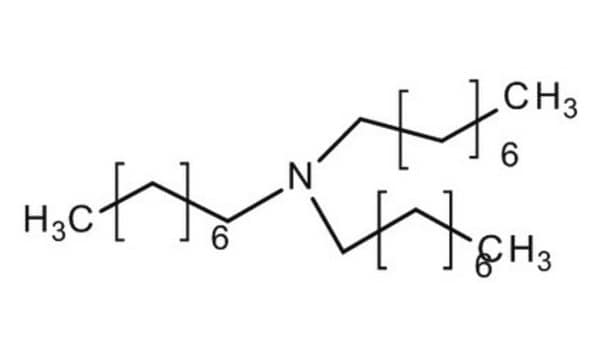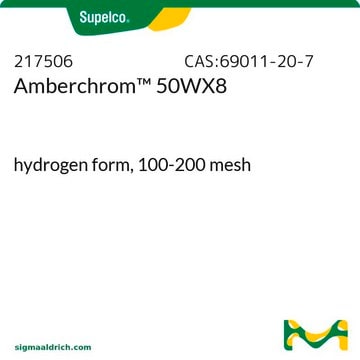471313
Tributylamine
≥98.5%
Synonyme(s) :
Tri-n-butylamine
About This Item
Produits recommandés
Densité de vapeur
6.38 (vs air)
Niveau de qualité
Pression de vapeur
0.3 mmHg ( 20 °C)
2.4 mmHg ( 55 °C)
Pureté
≥98.5%
Forme
liquid
Température d'inflammation spontanée
410 °F
Limite d'explosivité
6 %
Indice de réfraction
n20/D 1.428 (lit.)
pH
10.2 (25 °C, 0.1 g/L)
Point d'ébullition
216 °C (lit.)
Pf
−70 °C (lit.)
Densité
0.778 g/mL at 25 °C (lit.)
Chaîne SMILES
CCCCN(CCCC)CCCC
InChI
1S/C12H27N/c1-4-7-10-13(11-8-5-2)12-9-6-3/h4-12H2,1-3H3
Clé InChI
IMFACGCPASFAPR-UHFFFAOYSA-N
Vous recherchez des produits similaires ? Visite Guide de comparaison des produits
Description générale
Application
- An extraction solvent with CHCA (α-cyano-4-hydroxycinnamic acid) for the selective phospholipids (PLs) extraction from EVOO (extra virgin olive oil) and HO (hazelnut oil).
- A hydroxylating agent in the synthesis of spinel nickel ferrites (NiFe2O4) nanoparticles (NPs).
Caractéristiques et avantages
Mention d'avertissement
Danger
Mentions de danger
Conseils de prudence
Classification des risques
Acute Tox. 1 Inhalation - Acute Tox. 2 Dermal - Acute Tox. 4 Oral - Skin Irrit. 2
Code de la classe de stockage
6.1A - Combustible acute toxic Cat. 1 and 2 / very toxic hazardous materials
Classe de danger pour l'eau (WGK)
WGK 1
Point d'éclair (°F)
145.4 °F - closed cup
Point d'éclair (°C)
63 °C - closed cup
Certificats d'analyse (COA)
Recherchez un Certificats d'analyse (COA) en saisissant le numéro de lot du produit. Les numéros de lot figurent sur l'étiquette du produit après les mots "Lot" ou "Batch".
Déjà en possession de ce produit ?
Retrouvez la documentation relative aux produits que vous avez récemment achetés dans la Bibliothèque de documents.
Les clients ont également consulté
Notre équipe de scientifiques dispose d'une expérience dans tous les secteurs de la recherche, notamment en sciences de la vie, science des matériaux, synthèse chimique, chromatographie, analyse et dans de nombreux autres domaines..
Contacter notre Service technique













